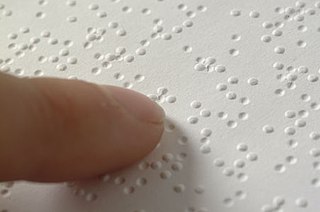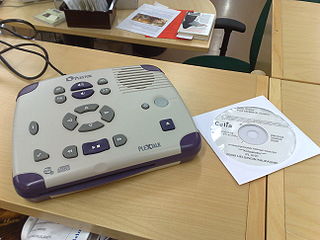Related Research Articles

Assistive technology (AT) is a term for assistive, adaptive, and rehabilitative devices for people with disabilities and the elderly. Disabled people often have difficulty performing activities of daily living (ADLs) independently, or even with assistance. ADLs are self-care activities that include toileting, mobility (ambulation), eating, bathing, dressing, grooming, and personal device care. Assistive technology can ameliorate the effects of disabilities that limit the ability to perform ADLs. Assistive technology promotes greater independence by enabling people to perform tasks they were formerly unable to accomplish, or had great difficulty accomplishing, by providing enhancements to, or changing methods of interacting with, the technology needed to accomplish such tasks. For example, wheelchairs provide independent mobility for those who cannot walk, while assistive eating devices can enable people who cannot feed themselves to do so. Due to assistive technology, disabled people have an opportunity of a more positive and easygoing lifestyle, with an increase in "social participation," "security and control," and a greater chance to "reduce institutional costs without significantly increasing household expenses." In schools, assistive technology can be critical in allowing students with disabilities access the general education curriculum. Students who experience challenges writing or keyboarding, for example, can use voice recognition software instead. Assistive technologies assist people who are recovering from strokes and people who have abstained injuries that effect their daily tasks.

Braille is a tactile writing system used by people who are visually impaired, including people who are blind, deafblind or who have low vision. It can be read either on embossed paper or by using refreshable braille displays that connect to computers and smartphone devices. Braille can be written using a slate and stylus, a braille writer, an electronic braille notetaker or with the use of a computer connected to a braille embosser.

A refreshable braille display or braille terminal is an electro-mechanical device for displaying braille characters, usually by means of round-tipped pins raised through holes in a flat surface. Visually impaired computer users who cannot use a standard computer monitor can use it to read text output. Deafblind computer users may also use refreshable braille displays.
Computer accessibility refers to the accessibility of a computer system to all people, regardless of disability type or severity of impairment. The term accessibility is most often used in reference to specialized hardware or software, or a combination of both, designed to enable the use of a computer by a person with a disability or impairment. Computer accessibility often has direct positive effects on people with disabilities.

A screen reader is a form of assistive technology (AT) that renders text and image content as speech or braille output. Screen readers are essential to people who are blind, and are useful to people who are visually impaired, illiterate, or have a learning disability. Screen readers are software applications that attempt to convey what people with normal eyesight see on a display to their users via non-visual means, like text-to-speech, sound icons, or a braille device. They do this by applying a wide variety of techniques that include, for example, interacting with dedicated accessibility APIs, using various operating system features, and employing hooking techniques.

The Perkins Brailler is a "braille typewriter" with a key corresponding to each of the six dots of the braille code, a space key, a backspace key, and a line space key. Like a manual typewriter, it has two side knobs to advance paper through the machine and a carriage return lever above the keys. The rollers that hold and advance the paper have grooves designed to avoid crushing the raised dots the brailler creates.
JAWS is a computer screen reader program for Microsoft Windows that allows blind and visually impaired users to read the screen either with a text-to-speech output or by a refreshable Braille display. JAWS is produced by the Blind and Low Vision Group of Freedom Scientific.
VoiceOver is a screen reader built into Apple Inc.'s macOS, iOS, tvOS, watchOS, and iPod operating systems. By using VoiceOver, the user can access their Macintosh or iOS device based on spoken descriptions and, in the case of the Mac, the keyboard. The feature is designed to increase accessibility for blind and low-vision users, as well as for users with dyslexia.
Tactile graphics, including tactile pictures, tactile diagrams, tactile maps, and tactile graphs, are images that use raised surfaces so that a visually impaired person can feel them. They are used to convey non-textual information such as maps, paintings, graphs and diagrams.

Digital accessible information system (DAISY) is a technical standard for digital audiobooks, periodicals, and computerized text. DAISY is designed to be a complete audio substitute for print material and is specifically designed for use by people with "print disabilities", including blindness, impaired vision, and dyslexia. Based on the MP3 and XML formats, the DAISY format has advanced features in addition to those of a traditional audio book. Users can search, place bookmarks, precisely navigate line by line, and regulate the speaking speed without distortion. DAISY also provides aurally accessible tables, references, and additional information. As a result, DAISY allows visually impaired listeners to navigate something as complex as an encyclopedia or textbook, otherwise impossible using conventional audio recordings.
A braille translator is a software program that translates electronic text into braille and sends it to a braille peripheral, such as a braille embosser. Typically, each language needs its own braille translator. Despite the use of the word translator, there is no language translation. Even in the simplest situation, such as Dutch braille, has complex rules for capitalization, emphasis, punctuation, typographic symbols, and page formatting.

Since the Global Positioning System (GPS) was introduced in the late 1980s there have been many attempts to integrate it into a navigation-assistance system for blind and visually impaired people.
NonVisual Desktop Access (NVDA) is a free and open-source, portable screen reader for Microsoft Windows. The project was started by Michael Curran in 2006.
Dolphin Computer Access is a British company based in Worcester that designs, creates and sells software for people who are blind or have vision and print impairments, dyslexia and other specific learning difficulties. The company was set up in 1986 and now has offices in the United Kingdom, United States, Sweden and Norway. Through the use of Dolphin's screen enlargers, screen readers and braille output, users can operate word processors, spreadsheets, databases and the internet. The company's customers include Microsoft, the Inland Revenue, the BBC, the Royal Air Force, New College Worcester and Vodafone.
Telesensory Systems, Inc. (TSI) was an American corporation that invented, designed, manufactured, and distributed technological aids for blind and low vision persons. TSI's products helped visually impaired people work independently with computers and with ordinary printed materials.
A sighted child who is reading at a basic level should be able to understand common words and answer simple questions about the information presented. They should also have enough fluency to get through the material in a timely manner. Over the course of a child's education, these foundations are built on to teach higher levels of math, science, and comprehension skills. Children who are blind not only have the education disadvantage of not being able to see: they also miss out on the very fundamental parts of early and advanced education if not provided with the necessary tools.
A BrailleNote is a computer made by HumanWare for persons with visual impairments. It has either a braille keyboard or a Qwerty Keyboard, a speech synthesizer, and a 32- or 18-column refreshable Braille display, depending on model. The "VoiceNote" is the same device without a braille display. The BrailleNote GPS is an 18 or 32 cell BrailleNote with an External GPS module, BrailleNote GPS.

A braille e-book is a refreshable braille display using electroactive polymers or heated wax rather than mechanical pins to raise braille dots on a display. Though not inherently expensive, due to the small scale of production they have not been shown to be economical.
Alternative formats include audio, braille, electronic or large print versions of standard print such as educational material, textbooks, information leaflets, and even people's personal bills and letters. Alternative formats are created to help people who are blind or visually impaired to gain access to information either by sight, by hearing (audio) or by touch (braille).
References
- ↑ Examples of braille technology Retrieved February 25, 2023]
- ↑ Dean, Katie (2000-02-24). "All Eyes on Braille Software". Wired. Retrieved 2008-07-01.
- ↑ Bar-Cohen, Yoseph (11 September 2009). "Electroactive polymers for refreshable Braille displays". SPIE.
- Braille Technology, American Foundation for the Blind